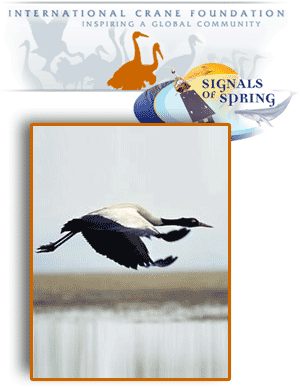 | In this Section: | |  | In the Spotlight |  | News |  |
List of "In the Spotlight" Features
The International Crane Foundation: Saving Cranes around the World

|
This spring, in cooperation with the International Crane Foundation, Signals of Spring students and students in China are tracking Black-necked Cranes in Asia! Cranes are a beautiful group of birds found on five out of the seven continents on Earth. There are approximately fifteen species of cranes, but of them, eleven are considered threatened, or at risk of extinction. Eight or nine of the crane species can be found in China, making it an important study site, although the International Crane Foundation works on every continent that cranes inhabit.
Black-necked cranes are a large crane similar to the Sandhill Crane of North America. They are very large compared to other cranes and omnivorous, eating fish, amphibians, insects, small mammals, and more commonly tubers, agricultural products and small aquatic plants. Their behavior is unique because they are the only alpine species of crane, meaning that they nest in the mountains, at high elevations. Black-necked cranes breed primarily in southwest China and in the mountains of Tibet and India, making these critical areas for research and conservation. This is why is is so important to study the critical habitats in the region.
Sara Moore, Program Assistant for the International Crane Foundation, stresses the importance of learning about, and developing a consciousness for these animals. Most species of cranes are in trouble because they require similar resources as humans. Cranes tend to rely on wetlands, marshy areas on the edges of ponds, lakes, and bays. Wetlands are important because they act as a nursery for many species of fish and birds, serving as a protective habitat for young animals. They are sponges of natures and filters, preventing floods and straining out pollutants. Wetlands tend to be very desirable places for both humans and wild animals, including cranes, to live. Unfortunately for the birds, humans often develop the land creating farms, houses, factories, and shopping malls, and effectively taking habitats away from the birds.
At its headquarters in Baraboo, Wisconsin, the International Crane Foundation, or ICF, runs education, captive breeding, and reintroduction programs. On their grounds, visitors can meet every species of crane and learn about their ecological importance. Researchers work to breed the animals, and then, when the chicks are old enough, reintroduce them into the wild. These reintroduction programs have been quite successful, particularly with the Whooping Crane, a North American native!
Reintroduction programs are a great example of the ICF philosophy that, "humans are an important part of the equation," Sara Moore explains. ICF stresses an "ecosystem approach" to conservation. Through their research, scientists learn which habitats and ecosystems are most critical to the birds and therefore most important to preserve. For example, the researchers use satellite tagging to study the behaviors and habitats, as well as the migration and feeding patterns, of the cranes.
Signals of Spring students can do their part to help the cranes by learning more about their habitat and resources, particularly those, "in their own backyard." Students can study the affects that humans have on the bird's habitats, particularly wetlands, for example through land development and pollution. Sara Moore says that the best thing people can do to help is to, "become informed about the animals and habitats, both locally and globally, and to start to see how our actions are affecting the environment." This season's Signals of Spring migration study is a great start.
|
